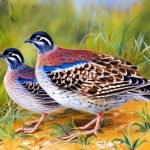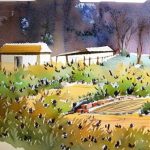A quail breeding pen is essential for anyone looking to breed quails for meat or eggs. It provides a controlled environment where quails can breed and lay eggs without the risk of predators or other environmental factors. By having a dedicated breeding pen, you can ensure the safety and well-being of your quails, as well as maximize the chances of successful breeding and egg production.
Furthermore, a breeding pen allows you to monitor and manage the health and behavior of your quails more effectively. This is crucial for identifying any potential issues early on and taking the necessary steps to address them. Additionally, a breeding pen provides a designated space for mating, nesting, and hatching, which can help reduce stress and competition among the quails. Overall, a well-designed and maintained quail breeding pen is key to a successful and sustainable quail breeding operation.
Table of Contents
- 1 Choosing the right location for your quail breeding pen
- 2 Designing and building your quail breeding pen
- 3 Selecting the right quail breed for your breeding pen
- 4 Maintaining and cleaning your quail breeding pen
- 5 Monitoring and managing the health of your quail in the breeding pen
- 6 Tips for successful quail breeding in your pen
- 7 FAQs
Key Takeaways
- A quail breeding pen is important for successful and controlled breeding of quails
- Choose a location for your quail breeding pen that is quiet, secure, and away from predators
- When designing and building your quail breeding pen, consider factors such as size, ventilation, and protection from the elements
- Select a quail breed that is well-suited for your breeding pen and your specific breeding goals
- Regularly maintain and clean your quail breeding pen to ensure the health and well-being of your quails
- Monitor and manage the health of your quails in the breeding pen to prevent and address any potential issues
- Successful quail breeding in your pen can be achieved by providing proper nutrition, minimizing stress, and ensuring optimal breeding conditions
Choosing the right location for your quail breeding pen
When selecting a location for your quail breeding pen, there are several factors to consider. First and foremost, the location should provide a safe and secure environment for the quails. This means choosing a spot that is protected from predators such as foxes, raccoons, and birds of prey. Additionally, the location should have good drainage to prevent waterlogging and ensure the pen remains dry and clean.
Furthermore, it’s important to consider the proximity to other animals and potential sources of stress for the quails. Loud noises, aggressive animals, or excessive human activity can all negatively impact the breeding success of your quails. Lastly, access to sunlight and fresh air is crucial for the health and well-being of the quails. Therefore, choosing a location with ample natural light and ventilation is essential for creating an optimal breeding environment.
Designing and building your quail breeding pen
When designing and building a quail breeding pen, there are several key elements to consider. The size of the pen is important, as it should provide enough space for the quails to move around comfortably and engage in natural behaviors such as dust bathing and foraging. Additionally, the pen should be constructed with durable materials that can withstand the elements and potential predator threats.
Furthermore, the design should include separate areas for nesting, mating, and feeding to accommodate the different needs of the quails. Providing adequate shelter from extreme weather conditions is also crucial for the health and well-being of the quails. Lastly, the pen should be easy to clean and maintain to ensure a hygienic environment for the quails. By carefully considering these design elements, you can create a breeding pen that promotes successful breeding and overall quail health.
Selecting the right quail breed for your breeding pen
Choosing the right quail breed for your breeding pen is essential for achieving your breeding goals. Different quail breeds have varying characteristics such as size, egg production, temperament, and adaptability to different environments. Therefore, it’s important to research and select a breed that aligns with your specific breeding objectives.
For example, if you are primarily interested in meat production, you may want to consider breeds such as Coturnix or Bobwhite quails, which are known for their fast growth and high meat yield. On the other hand, if you are focused on egg production, breeds like Coturnix or Pharaoh quails are known for their prolific egg-laying capabilities. Additionally, considering factors such as climate tolerance and disease resistance can also help you select a breed that is well-suited to your local environment. By carefully evaluating the characteristics of different quail breeds, you can make an informed decision that sets the stage for successful breeding in your pen.
Maintaining and cleaning your quail breeding pen
Maintaining a clean and hygienic environment in your quail breeding pen is crucial for the health and well-being of your quails. Regular cleaning and maintenance help prevent the spread of diseases, reduce stress on the quails, and promote successful breeding and egg production. This involves removing soiled bedding, feces, and leftover food on a regular basis to prevent the buildup of bacteria and parasites.
Additionally, providing clean water and regularly sanitizing feeding and watering equipment is essential for preventing contamination and promoting good health in your quails. It’s also important to regularly inspect the pen for any signs of wear and tear or potential safety hazards that could pose a risk to the quails. By staying on top of maintenance and cleaning tasks, you can create a safe and healthy environment that supports successful breeding in your pen.
Monitoring and managing the health of your quail in the breeding pen

Monitoring and managing the health of your quails in the breeding pen is essential for preventing disease outbreaks and ensuring overall well-being. This involves regularly observing the behavior and appearance of your quails to identify any signs of illness or distress. Common indicators of poor health in quails include lethargy, decreased appetite, abnormal droppings, respiratory issues, or changes in feather condition.
In addition to visual observation, it’s important to implement a regular health monitoring program that includes routine checks for parasites, vaccinations if necessary, and periodic health screenings by a veterinarian. Furthermore, providing a balanced diet with access to clean water and appropriate supplements can help support the immune system and overall health of your quails. By staying vigilant and proactive in monitoring and managing the health of your quails, you can minimize the risk of disease and promote successful breeding outcomes in your pen.
Tips for successful quail breeding in your pen
To maximize the success of quail breeding in your pen, there are several tips to keep in mind. First and foremost, providing a balanced diet that meets the nutritional needs of your quails is crucial for promoting healthy egg production and overall reproductive success. This includes offering a high-quality commercial feed supplemented with fresh greens, protein sources, and calcium for eggshell formation.
Additionally, creating a stress-free environment by minimizing disturbances, providing adequate space, and reducing overcrowding can help promote natural mating behaviors and successful egg incubation. It’s also important to carefully monitor egg production and fertility rates to identify any potential issues early on and take corrective action if necessary. Lastly, maintaining optimal environmental conditions such as temperature, humidity, and lighting can help support healthy egg development and hatching success. By implementing these tips and best practices, you can increase the likelihood of successful quail breeding in your pen.
If you’re considering setting up a quail breeding pen, you might also be interested in learning about the importance of providing a safe and comfortable living space for your chickens. Poultry Wizard offers valuable insights on creating an ideal environment for your chickens with their article on chicken coop designs in Muskegon. Understanding the principles of coop design can help you optimize the living conditions for your quails and ensure their well-being.
FAQs
What is a quail breeding pen?
A quail breeding pen is a specially designed enclosure or structure used for the purpose of breeding and raising quail. It provides a controlled environment for quail to mate, lay eggs, and raise their young.
What are the key components of a quail breeding pen?
A quail breeding pen typically includes nesting boxes, perches, feeders, waterers, and a secure fencing or netting to keep the quail contained. It may also have a separate area for incubating eggs and raising chicks.
How big should a quail breeding pen be?
The size of a quail breeding pen will depend on the number of quail being housed. As a general guideline, each quail should have at least 1 square foot of space in the pen. It’s important to provide enough space for the quail to move around comfortably and engage in natural behaviors.
What are the important considerations for setting up a quail breeding pen?
When setting up a quail breeding pen, it’s important to consider factors such as ventilation, lighting, temperature control, and predator protection. The pen should also be easy to clean and maintain to ensure the health and well-being of the quail.
What are the benefits of using a quail breeding pen?
A quail breeding pen provides a controlled environment for breeding and raising quail, which can lead to higher success rates in hatching and raising chicks. It also allows for easier monitoring of the quail’s health and behavior, and can help protect them from predators.
Meet Walter, the feathered-friend fanatic of Florida! Nestled in the sunshine state, Walter struts through life with his feathered companions, clucking his way to happiness. With a coop that’s fancier than a five-star hotel, he’s the Don Juan of the chicken world. When he’s not teaching his hens to do the cha-cha, you’ll find him in a heated debate with his prized rooster, Sir Clucks-a-Lot. Walter’s poultry passion is no yolk; he’s the sunny-side-up guy you never knew you needed in your flock of friends!







